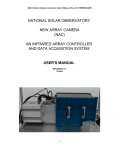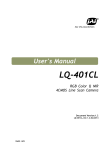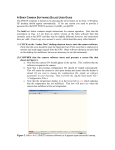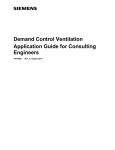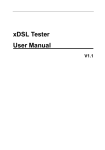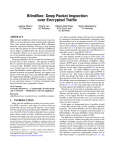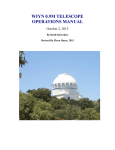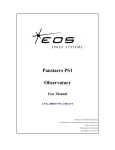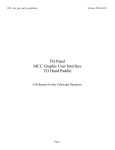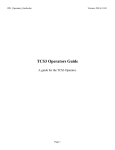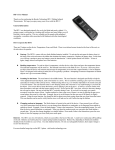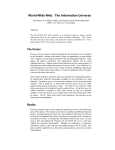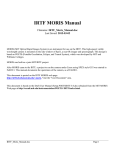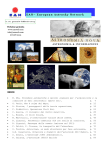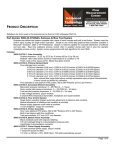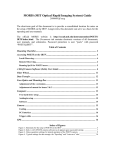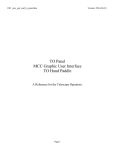Download - NASA Infrared Telescope Facility
Transcript
NASA IRTF / UNIVERSITY OF HAWAII Document #: RQD-1.2.1.3-00-X Created on : Jun 15/10 Last Modified on : Sep 06/10 INSTRUMENT TOP LEVEL SPECIFICATION Original Author: Tim Bond Latest Revision: Tim Bond Approved by: XX NASA Infrared Telescope Facility Institute for Astronomy University of Hawaii Revision History Revision No. Rev 1 Author & Date Approval & Date Description A. Tokunaga – Sep 13/10 T. Bond - Preliminary Release. Page 1 of 34 TMP-inst-spec_ATT06sep10-1.doc Created by Tim Bond TMP-inst-spec_ATT06sep10-1.doc Page 2 of 34 TMP-inst-spec_ATT06sep10-1.doc Created by Tim Bond Contents 1 Introduction.................................................................................................................................6 1.1 Project Background......................................................................................................6 1.2 Document Purpose ...................................................................................................... 6 1.3 Applicable and Reference Documents......................................................................... 6 1.4 Abbreviations................................................................................................................ 6 2 Instrument Reference Design.....................................................................................................7 2.1 Overview........................................................................................................................7 2.2 Basic Layout................................................................................................................. 7 2.3 Detector Packages and Associated Electronics........................................................... 8 2.4 Observing Modes and Calibration............................................................................... 9 2.5 Acquisition and Guiding.............................................................................................. 9 3 Instrument Design Constraints / Design Guidelines..............................................................10 3.1 iSHELL as a IRTF Facility Instrument (Design Constraint)..................................10 3.2 Array Selection (Design Constraint)..........................................................................10 3.3 Array Controller Electronics (Design Constraint).................................................... 11 3.4 Immersion Gratings (Design Constraint).................................................................. 11 3.5 Post Processing Software (Design Guideline)........................................................... 11 4 Summary of Top Level Science Requirements....................................................................... 13 4.1 Resolving Power......................................................................................................... 13 4.2 Sensitivity.................................................................................................................... 13 4.3 Wavelength Coverage................................................................................................. 14 4.4 One-shot Simultaneous Wavelength Coverage.........................................................14 4.5 Slit Widths................................................................................................................... 15 4.6 Sampling..................................................................................................................... 15 4.7 Slit Lengths................................................................................................................. 15 4.8 Signal to Noise Ratio Limits.......................................................................................15 4.9 Velocity Precision........................................................................................................15 4.10 Radial Velocity Precision..........................................................................................15 4.11 Spectral Response Function.....................................................................................16 4.12 Cadence.....................................................................................................................16 4.13 Absolute Flux Calibrations...................................................................................... 16 4.14 Observing Efficiency................................................................................................ 16 5 Optical Requirements:..............................................................................................................18 5.1 Existing Telescope Optics........................................................................................... 18 5.2 Image Quality at the Spectrograph Slit..................................................................... 18 5.3 Image Quality at the Spectrograph Detector.............................................................18 5.4 Image Quality at the Slit Viewer Detector................................................................. 19 5.5 Cold Stop Alignment...................................................................................................19 6 Detector Requirements:............................................................................................................20 6.1 Mechanical Interface................................................................................................. 20 6.2 Thermal Interface.......................................................................................................20 Page 3 of 34 TMP-inst-spec_ATT06sep10-1.doc Created by Tim Bond 6.3 Optical Interface......................................................................................................... 20 6.4 Electrical Interface..................................................................................................... 20 7 Mechanical Requirements:...................................................................................................... 21 7.1 Repeatability of Alignment on Telescope...................................................................21 7.2 Rigidity on Telescope.................................................................................................. 21 7.3 Mass and Center of Gravity Requirements................................................................21 7.4 Volume Requirements.................................................................................................22 7.5 Vacuum System Requirements................................................................................... 22 7.6 Mechanism Operational Requirements..................................................................... 22 7.7 Instrument Handling..................................................................................................23 7.8 Servicing and Access Requirements.......................................................................... 23 8 Thermal Requirements:........................................................................................................... 24 8.1 Cool Down Time......................................................................................................... 24 8.2 Cool Down Rates........................................................................................................ 24 8.3 Warm Up Time............................................................................................................ 24 8.4 Warm Up Rates........................................................................................................... 24 8.5 Temperature Gradients...............................................................................................24 8.6 Alignment at Room Temperature............................................................................... 25 8.7 Thermal Repeatability................................................................................................ 25 8.8 Optical Bench/Mechanism Temperature Stability.................................................... 25 8.9 Detector Temperature Stability.................................................................................. 25 8.10 Immersion Grating Temperature Stability...............................................................25 9 Control System Requirements:................................................................................................26 9.1 General Control Strategy........................................................................................... 26 9.2 Controller Types & Physical Requirements.............................................................. 26 9.3 Control System Performance..................................................................................... 26 10 Electrical and Electronic Requirements:.............................................................................. 27 10.1 Grounding and Shielding Requirements.................................................................27 10.2 Electrostatic Discharge Requirements.....................................................................27 10.3 Power Requirements.................................................................................................27 11 Software Requirements:......................................................................................................... 28 11.1 IRTF Software Requirements.................................................................................. 28 11.2 Software SubSystems................................................................................................ 28 12 External Interface Requirements:.........................................................................................29 12.1 Mounting on MIM and Telescope............................................................................29 12.2 Helium Line Interfaces............................................................................................ 29 12.3 Liquid Nitrogen Access Ports...................................................................................30 12.4 Electrical Interface Connections............................................................................. 30 12.5 Power Connections...................................................................................................30 12.6 Vacuum System Connections................................................................................... 30 13 Environmental Requirements:...............................................................................................31 13.1 Transportation / Shipping Environment................................................................. 31 13.2 Facility Storage / Operation Environment.............................................................. 31 13.3 Instrument Operation Environment........................................................................ 32 14 Other Additional Requirements:........................................................................................... 33 Page 4 of 34 TMP-inst-spec_ATT06sep10-1.doc Created by Tim Bond 14.1 Documentation (Users Manual).............................................................................. 33 14.2 Documentation (Service Manual)............................................................................33 14.3 Documentation (As-Built Drawings)....................................................................... 33 14.4 Reliability.................................................................................................................. 33 14.5 Expected Instrument Lifetime..................................................................................33 14.6 Safety Requirements.................................................................................................33 Page 5 of 34 TMP-inst-spec_ATT06sep10-1.doc Created by Tim Bond 1 Introduction 1.1 Project Background iSHELL is to be a facility-class infrared cross-dispersed spectrograph developed for the IRTF using silicon immersion grating technology. As a goal, this instrument will provide a resolving power of up to 80,000 at 1.2–2.5 μm and 70,000 at 3–5 μm. No other spectrograph in the Northern Hemisphere presently provides such a high resolving power at near infrared wavelengths. Silicon immersion gratings are to be incorporated into the design to keep iSHELL manageably small (about the same size as the IRTF facility instrument, SPEX). The immersion grating design will have the advantage of allowing high spectral resolving power without requiring an extremely narrow slit or large collimated beam diameters. This will be the first facility instrument at 1–5 μm to employ an immersion grating, and therefore it will be an important demonstration of this new technology for future instrumentation. The total instrument budget for iSHELL has been secured from several different sources – NSF, NASA, UH, and through the IRTF operations budget itself. The total budget of the instrument is approximately $4M and it has been estimated to require about 14 man years of effort (distributed over 4 years) to reach completion. 1.2 Document Purpose This document shall serve as a starting point for the technical staff for development of the iSHELL instrument. Requirements stated in this document shall be clear, concise, and given in a way that the technical team will easily understand, and will be able to carry on the design process with them. All of the requirements in this document will be traceable to higher level requirements (as given in sections 3 and 4), and should be derivable from them. 1.3 Applicable and Reference Documents Document Title Document Number Science Case (SC) Science Requirements Document (SRD) SGIR Controller Requirements Document 1.4 Abbreviations SC SRD Science Case Science Requirements Document Page 6 of 34 TMP-inst-spec_ATT06sep10-1.doc Created by Tim Bond 2 Instrument Reference Design A general description of the instrument is given here as a basis for discussion. This description can be considered as a pre-conceived instrument concept or “strawman design” from which further refinements and/or developments shall occur. It is presented only to give the reader a general flavor of the instrument, and the description given in this reference design should not be interpreted as any kind of established development or requirement of the instrument. 2.1 Overview iSHELL is being designed for a resolving power of R ~ 70,000 and increased one-shot wavelength coverage (δ λ ~ λ/10 µ m). This is achieved through the use of a cross-dispersed optical design and a 2048 x 2048 NIR array. Because iSHELL is designed to maximize science return in the areas of planetary science, star formation, the interstellar medium, and galactic astronomy, the instrument is optimized for the H, K, and L bands. The M band and part of the J band are also accessible. Silicon immersion gratings are used to keep iSHELL manageably small (about the same size as SPEX) and affordable. Absorption in silicon results in a short wavelength cut-off in the J band at about 1.15 µ m. Availability of large format arrays limits the long wavelength cut-off is to about 5 µ m. Slit lengths in the range ~5-25˝ are needed for point sources and extended objects (e.g. comets and planets). 2.2 Basic Layout The iSHELL cryostat is mounted on the telescope at the cassegrain focus. At this focus location the beam speed is approximately f/38. Inside the cryostat are three major optical sub-assemblies: the fore-optics, the slit viewer, and the spectrograph. In the fore-optics the f/38 beam from the telescope enters the cryostat through the entrance window and comes to a focus at the telescope focal plane (TFP). A dichroic just inside the entrance window transmits the optical beam out of the cryostat through the exit window and into a wavefront sensor (WFS), and the infrared beam is reflected. The TFP is re-imaged onto the slit wheel by a collimator-camera system. A pupil image is formed following the collimator mirror and the system cold stop is placed here. A k-mirror image rotator is located immediately behind the cold stop. Reflective slits in the slit wheel send the field surrounding the slit into the slit viewer. Here a refractive collimatorcamera re-images the slit field onto a Raytheon 512x512 InSb array. A filter wheel in the slit viewer allows a selection of filters to be used for object acquisition, guiding, and scientific imaging. A lens in the filter wheel is used to image the telescope pupil. This pupil viewer (PV) provides a means to align the cryostat on the telescope. The slit viewer will operate independently of the spectrograph. The f/38 beam enters the spectrograph through the slit and order-sorting filter wheel. It is then folded and collimated at the first off-axis parabola (OAP1). The silicon immersion grating (IG) is located at the pupil following OAP1. An in/out mirror close to the pupil is able to select either of two IGs (IG1 covers 1.1-2.5 µ m and IG2 covers 2.8-5.3 µ m). The IG is tilted slightly so that the emerging beam is reflected at OAP1 to form a dispersed image of the slit at the spectrum mirror. The beam reflected at the spectrum mirror is re-collimated at OAP2 and forms a second “white” pupil image at the cross-disperser (XD) mechanism. Gratings in the XD wheel send the beam into the spectrograph camera lens, which images the resulting spectrum onto a 2048x2048 H2RG array. A calibration unit (CU) is located on top of the cryostat. It contains illuminating optics, an integrating sphere, arc and flat-field lamps, and a gas cell. An in-out mirror above the entrance window is used to project calibration light into the instrument. A gas cell is mounted on a two-position stage between the entrance window and in-out mirror so that it can be placed into the beam for radial velocity (RV) science observations. An option for precision wavelength calibration required for RV science is to feed the output of a laser frequency comb into the integrating sphere. Due to Page 7 of 34 TMP-inst-spec_ATT06sep10-1.doc Created by Tim Bond its size (≈ 1m3) and stability required, the laser comb is located in the instrument preparation room and its output fed to the integrating sphere via an optical fiber. Figure #2 shows a general schematic layout of iSHELL. Figure #2: iSHELL schematic layout The cryostat is of similar size to SPEX (≈ 1m3) and will nominally uses the same cooling scheme. It contains an optical bench to which the optical sub-assemblies are mounted. The optics and bench are cooled to ≈ 75K using a liquid nitrogen can. The radiation load on the cold structure is minimized by surrounding it with a radiation shield, which is cooled using the first stage of a Cryodyne 1050 CP closed-cycle cooler. The spectrograph and slit viewer arrays are cooled to 38K and 30K respectively, using the second stage of the cooler. Cooling to operational temperature will take about three days (components in the mechanism wheels take longest to cool). 2.3 Detector Packages and Associated Electronics An in-house STARGRASP infrared (SGIR) array controller runs the spectrograph and slit viewer array. There are three subsystems, the cryostat-mounted electronics chassis, a power supply, and a computer connected via a local area network. The cryostat-mounted chassis has multiple slots that each houses an electronic board-set. Each boardset consists of a PowerPC CPU and large FPGA, 512 MB DRAM, 16 10Mhz 16-bit ADCs, and programmable bias and clock level generators. These handle the generation of array biases and clocks and the amplification, digitization, and transport of pixel data to the computer (called a pixelserver). Control and data transport is Page 8 of 34 TMP-inst-spec_ATT06sep10-1.doc Created by Tim Bond accomplished over a one-gigabit fiber Ethernet interface. The software running on the PowerPC CPU is open source C code. The power supply is an Ethernet controllable multiple output system that supplies the necessary voltages to the controller chassis. The LINUX computer is completely off-the-shelf with no additional plug-in boards and there is no particular favored vendor. 2.4 Observing Modes and Calibration iSHELL has three basic spectroscopy modes. Short cross-dispersed mode (SXD) covers observations done at ~1-2.5 µ m. Radial velocity (RV) mode is a subset of SXD mode in which observations are made through a gas cell. Long cross-dispersed mode (LXD) covers observations done at ~2.8-5.3 µ m. In addition, the infrared slit viewer that is used for acquisition and guiding, can also be used for scientific imaging. Standard calibration requires obtaining flat field, and arc lamp exposures. Typically these will be acquired immediately following an object and standard star observing sequence. This requires that the spectrograph configuration not be changed. The only change will be to move the external in/out mirror into the beam so that the spectrograph can view the calibration lamps. The calibration sequences will be run under command of calibration macros. Some observations will only require relatively low precision and the calibration for these programs can be done at the end or beginning of the night, or during the day. This will require changing the instrument configuration to match the program. Since mechanisms do not reposition precisely calibration is not as precise. Radial velocity programs require very precise wavelength calibration and this is achieved by doing the wavelength calibration simultaneously with the observations with the use of a gas cell inserted into the beam immediately above the cryostat window. Standard calibrations will also be required immediately following the observations with the gas cell still in place. We are also considering the use of a laser comb for precise wavelength calibration of radial velocity observations but details are TBD. 2.5 Acquisition and Guiding Target acquisition and guiding is executed with the infrared slit viewer. Due to the high background at wavelengths longer than ~2.5 µ m this is usually done in the J, H, K, or similar wavelength narrow-band filters. Once the target is acquired it is placed in the slit by offsetting the telescope and guiding started. Since guiding is implemented by offsetting the telescope, guiding is necessarily slow and corrects telescope tracking at rates of <0.3 Hz. In most cases guiding will be done on spill-over from the target star in the slit. Alternatively, a guide star in the FOV of the slit viewer can be used. The centroid of extended objects can be guided on by increasing the size of the guide box. The guiding scheme is very similar to that successfully used in SPEX (see Figure 21). The only differences are the smaller FOV and pixel scale (30″ x30″ and 0.06″ /pixel respectively). With further development it may also be possible to guide on features in extended objects (in particular, planets) by using cross-correlation techniques. Since iSHELL works at high resolving powers its targets will be intrinsically brighter than those observed with SPEX, making guiding easier. Page 9 of 34 TMP-inst-spec_ATT06sep10-1.doc Created by Tim Bond 3 Instrument Design Constraints / Design Guidelines iSHELL has several design constrains / design guidelines imposed upon it. These are not specifications or requirements as dictated by the science case for the instrument. In fact they are simply guidelines or constraints that have come about largely by legacy type issues, financial matters, politically motivated forces, available effort, or possible use of existing infrastructures. 3.1 iSHELL as a IRTF Facility Instrument (Design Constraint) [iSHELL Science Requirements Document, FR_1] iSHELL is to be used as a general facility instrument at the IRTF. It shall be designed in such a way as to take advantage of the existing infrastructure at the IRTF and to be used in such a way as not to significantly increase the overhead required to maintain the IRTF instrument suite. iSHELL will be mounted to the bottom of the telescope on the existing MIM structure, and will be easily interchangeable with the other existing IRTF instruments. iSHELL will be made available to the general IRTF community. The instrument will fit within an envelope that can be accommodated on the existing MIM, and the instrument will not exceed a mass that cannot be handled by the MIM and/or Telescope. The instrument shall utilize wherever possible, existing services provided to back of the telescope, and if additional services are required, they will be included in the design. The instrument will be designed to accept the existing F38 (approx) beam delivered by the telescope, and the instrument shall be capable of existing and operating within the IRTF dome environment. 3.2 Array Selection (Design Constraint) [iSHELL SRD, FR_2] There are two arrays used in iSHELL, a 512x512 InSb array used in the slit viewer, and a 2048x2048 H2RG array used in the spectrograph. Properties of the two detectors are as follows: SLIT VIEWER DETECTOR Detector Manufacturer # of Pixels Pixel Pitch Aladdin II InSb SBRC / Raytheon 512 x 512 27 um SPECTROGRAPH DETECTOR Detector Manufacturer # of Pixels Pixel Pitch HAWAII H2RG Teledyne 2048 x 2048 18 um Additional information (ITAR sensitive) may be found in attachment X Page 10 of 34 TMP-inst-spec_ATT06sep10-1.doc Created by Tim Bond 3.3 Array Controller Electronics (Design Constraint) [Decision was made to use the Teledyne H2RG array for the spectrograph and to use a Raytheon Aladdin II InSb array for the slit viewer. The former was purchased; the latter was provided by M. Mumma at Goddard as part of the collaboration.] The array controller electronics to be used is an iteration of the STARGRASP detector controller utilized on the PANSTARRS science cameras. The electronics was developed here at the IFA and identical electronics has been under development for upgrades to several of the other facility instruments (SPEX and NSFCAM2). It is highly desirable to use a similar (if not identical) electronics suite for all of the facility instruments on the telescope. Many of the array/controller performance statistics are ITAR sensitive; however, a summary of the non-sensitive characteristics are given below: SPECTROGRAPH DETECTOR/CONTROLLER : Teledyne H2RG Read Out Max/Min Integration MODE Overhead (s) Time (s) 3600 / 60 Slow <30 60 / 5 Standard <1.0 5/~0.5 Fast <0.1 Typical Integration Time (s) 600 x 6 cycles 10 (6 co-adds) 1 (10 co-adds) SLIT VIEWER DETECTOR/CONTROLLER : Raytheon Aladdin II InSb Read Out Max/Min Integration Typical Integration MODE Overhead (s) Time (s) Time (s) 300 / 10 30 (1 co-add) Slow <5.0 10 / 1 1 (2 co-adds) Standard <1.0 1 / <0.1 0.1 (10 co-adds) Fast <0.1 Max Cadence (TBD) ~30 frames/hr ~10 frame/min ~30 frames/min Max Cadence ~5 frames/min ~30 frames/min ~60 frames/min Additional information (ITAR sensitive) may be found in attachment X 3.4 Immersion Gratings (Design Constraint) [iSHELL SRD, FR_1] One of the main goals of the original NSF Proposal for funding was to develop a spectrograph utilizing a silicon immersion grating as a proving ground for this technology. The silicon immersion grating has been produced, and is being supplied by one of the Co-PI’s in Texas (Dan Jaffe). It is important to incorporate this technology to meet the original goals of the NSF proposal. 3.5 Post Processing Software (Design Guideline) [iSHELL SRD, FR_3] A variety of software tools will be provided with the instrument that will help to make the instrument more effective and efficient. This software suite will be developed and provided by the instrument team, and additional tools may be provided at the request of observers based on the perceived advantage of such developments. There are anticipated, two different types of software tools; one set for post observation data analysis, and one set for use during the observations to expedite the observing process. These tools will provide the following functionality: Page 11 of 34 TMP-inst-spec_ATT06sep10-1.doc Created by Tim Bond FUNCTION 1 FUNCTION 2 FUNCTION 3 Page 12 of 34 TMP-inst-spec_ATT06sep10-1.doc Created by Tim Bond 4 Summary of Top Level Science Requirements The following top level science requirements were identified from the proposed Science Cases. Some rationalization has gone on with respect to these requirements. As could be expected with any instrument, it simply is not possible to have all of the desired functionally in a realistic instrument, and as such, some sacrifices have to be made. It is the opinion of the team that the following requirements will provide for a very effective instrument, at an extremely reasonable cost. 4.1 Resolving Power [iSHELL SRD, SR_1] Spectral resolving power R=λ/∆λ at the center of the waveband shall be: R ≥ 70 000 R = 80 000 . Where λ required. goal. is the wavelength. is the smallest resolved wavelength interval (using Rayleigh criterion). ∆λ 4.2 Sensitivity [iSHELL SRD, SR_2] iSHELL shall have point-source sensitivities of: J Required Goal ≥ ≥ H 10.5 10.7 ≥ ≥ K 10.0 10.2 ≥ ≥ L′ 9.5 9.8 ≥ ≥ M′ 7.4 7.7 for S/N =100 in 3600 s at R=70 000 (Vega magnitudes) To achieve this sensitivity, the average throughput shall be: (1) ≥ 0.05 required. (2) ≥ 0.10 goal. [iSHELL SRD, TR_1] In addition, the read noise shall be: (1) a. ≤ 5 e RMS with NDRs and read out overhead < 30.0 s b. ≤ 15 e RMS with NDRs and read out overhead < 1.0 s c. ≤ 100 e RMS with NDRs and read out overhead < 0.1 s required. (2) a. ≤ 2 e RMS with NDRs and read out overhead < 30.0 s b. ≤ 7 e RMS with NDRs and read out overhead < 1.0 s c. ≤ 50 e RMS with NDRs and read out overhead < 0.1 s goal. [iSHELL SRD, TR_2] Page 13 of 34 ≥ ≥ 5.0 5.3 TMP-inst-spec_ATT06sep10-1.doc Created by Tim Bond In addition, the dark current shall be: (1) ≤ 0.1 e/s (2) ≤ 0.01 e/s required. goal. [iSHELL SRD, TR_3] In addition, the instrument background shall be: (1) ≤ 0.01 e/s/pixel required. [iSHELL SRD, TR_5] 4.3 Wavelength Coverage [iSHELL SRD, SR_3] The instrument shall have the capability to position any wavelength in the range 1.2 - 5.2 µ m in the center of the array cross-dispersion axis and the simultaneous wavelength range shall be continuous. 4.4 One-shot Simultaneous Wavelength Coverage [iSHELL SRD, SR_4] The simultaneous (i.e. one-shot) wavelength coverage of the instrument and shall be: δ λ ≤ λ/10 δ λ ≤ λ/5 δλ , is the continuous wavelength range covered in one setting required. goal. Where λ is the central wavelength setting of the instrument In order to achieve this the pixel-field-of-view shall be: (1) 0.125″ per pixel in dispersion direction required. [iSHELL SRD, TR_4] Page 14 of 34 TMP-inst-spec_ATT06sep10-1.doc Created by Tim Bond 4.5 Slit Widths [iSHELL SRD, SR_5] The slit width matched to R=70 000 shall be 0.375 arcsec. A selection of wider slits shall be available for better sensitivity in a range of seeing conditions and for improved sensitivity when higher resolving power is not needed: 0.75 arcsec (R=39 000) 1.50 arcsec (R=20 000) 3.00 arcsec (R=10 000; wide slit for absolute spectro-photometry) 4.6 Sampling [iSHELL SRD, SR_6] The smallest spectral resolution element (R=70 000) shall be sampled by 3.0 pixels. 4.7 Slit Lengths [iSHELL SRD, SR_7] A selection of slit lengths shall be provided: 10.0 arcsec 15.0 arcsec 25.0 arcsec 5.0 arcsec required required required optimal 4.8 Signal to Noise Ratio Limits [iSHELL SRD, SR_8] Systematic noise effects shall not limit the measured S/N to less than 1000. 4.9 Velocity Precision [iSHELL SRD, SR_9] Without special calibration iSHELL shall enable the measurement of velocity of: ≤ ≤ 1 km/s 0.4 km/s required goal The velocity measurement shall be stable over a period of hours 4.10 Radial Velocity Precision [iSHELL SRD, SR_10] With special calibration iSHELL shall enable the measurement of velocity of: Page 15 of 34 TMP-inst-spec_ATT06sep10-1.doc Created by Tim Bond ≤ ≤ ≤ 20 m/s 10 m/s 5 m/s required optimal goal The radial velocity measurement shall be stable over a period of months 4.11 Spectral Response Function [iSHELL SRD, SR_11] To achieve a radial velocity precision about 10 m/s RMS the skewness, defined by the dimensionless third moment µ 3, must be known at all times to within ± 0.01. This requires: a. that provision shall be made to measure µ 3 to ± 0.01 (arc lines or laser fringes); b. that µ 3 of the instantaneous optical SRF shall be stable between measurements (e.g. daytime calibration) to this precision or better; c. that µ 3 for the effective SRF, being the combination of the optical SRF in b. and any smearing brought about by image drift during the course of an observation, shall be kept stable to within the same to ± 0.01; this requires the image motion across the face of the detector be ≤ 0.1 pixel during an observation 4.12 Cadence [iSHELL SRD, SR_12] The spectrograph shall be capable of taking and storing full array data at a sustained rate of up to 10 full data frames per minute (standard read out) with a goal of up to 30 frames per minute (fast read out). 4.13 Absolute Flux Calibrations [iSHELL SRD, SR_13] The instrument shall be capable of measuring absolute flux to an accuracy of: ≤ ≤ 2 % requirement 1 % goal 4.14 Observing Efficiency [iSHELL SRD, SR_14] iSHELL shall have “open shutter” efficiencies (total exposure time / total elapsed time) of: ≥ ≥ 67 % for 10 min observation 92 % for a one-hour observing block Overheads taken to include: telescope slew, acquisition, guider setup, and instrument configuration (not more than 5 mins) Page 16 of 34 TMP-inst-spec_ATT06sep10-1.doc Created by Tim Bond Overheads do not include calibration (flats, arcs etc.), and observations of standard stars Page 17 of 34 TMP-inst-spec_ATT06sep10-1.doc Created by Tim Bond 5 Optical Requirements: iSHELL shall meet the general optical requirements listed below. 5.1 Existing Telescope Optics The optical design will assume the following with respect to the existing optics of the telescope: IRTF Primary mirror: Parabolic Concave Focal length = 7642.225 mm [300.875 inches] Conic Constant = -1 IRTF Secondary mirror (undersized to define pupil for IR applications): Focal Length 1 = Focal Length 2 = Outer Diameter = 243.84 mm [9.6 inches] Inner Diameter (reflective button) = 48.8 mm [1.921 inches] Primary / Secondary Separation Distance (vertex to vertex) = 7022.225 mm Primary Vertex to Instrument mounting face distance = 1610.61mm Primary Vertex to telescope focal plane distance = 2057.777 mm 5.2 Image Quality at the Spectrograph Slit [iSHELL SRD, TR_9] The fore-optics must not degrade the best image FWHM delivered by the telescope of about 0.4″ (a Gaussian to a good approximation) by more than 5%. This is met with: 50% EED ≤ 60 µ m At the telescope the best image quality is dominated by seeing; best image FWHM about 0.4″ (220 µ m). The requirement is derived by convolving the telescope image profile (Gaussian) and the spot diagram EED (Gaussian distribution). A degradation of 5% in the image quality at the slit reduces the spectrograph throughput by about 3%. 5.3 Image Quality at the Spectrograph Detector [iSHELL SRD, TR_8] The image quality at the spectrograph detector shall not degrade the slit-limited spectra resolving power by more than 10% to maintain R > 70,000. This requires: 50% EED ≤ 18 µ m This is specified in the dispersion direction (x-axis). Lower image quality in the cross-dispersion direction (y-axis) does not affect spectral resolving power. The slit-limited resolving power is R=80,000 (FWHM) matched to a 3pixel wide slit. Refocusing of the spectrograph detector with wavelength is allowed. The image quality in the spectrograph is dominated by the performance of the spectrograph camera lens. The requirement is derived by convolving the profiles due to the slit (Gaussian FWHM 3.0 pixels by design) and the spot diagram EED (a Gaussian distribution to a good approximation) Page 18 of 34 TMP-inst-spec_ATT06sep10-1.doc Created by Tim Bond 5.4 Image Quality at the Slit Viewer Detector [iSHELL SRD, TR_10] The SV in series with the fore-optics must not degrade the best image FWHM delivered by the telescope of about 0.4″ (a Gaussian to a good approximation) by more than 10%. In the SV this is met with: 50% EED ≤ 27 µ m The origin of this requirement comes from the desire for iSHELL to not noticeably degrade the best images delivered by the telescope (sensitivity and spatial information). The requirement is derived by convolving the image profile at the slit (Gaussian) and the SV spot diagram EED (Gaussian distribution). 5.5 Cold Stop Alignment To achieve an absolute flux calibration of 1%, the cold stop and telescope exit pupil need to remain co-aligned to within 1% of their diameters both while observing the object, and while performing the flux standard star observations. Page 19 of 34 TMP-inst-spec_ATT06sep10-1.doc Created by Tim Bond 6 Detector Requirements: iSHELL shall meet the general requirements listed below for both the spectrograph detector and the slit viewer detector. 6.1 Mechanical Interface The detector shall be mounted such a way that, once initially adjusted, it can be removed, and reinstalled without necessitating optical realignment. The detector shall be mounted such a way that it shall remain in a stress free state during cool down / warm up, or if exposed to any thermal gradients as specified in Sec. 8.3 6.2 Thermal Interface The detector shall be mounted in such a way that it is thermally isolated, and capable of being thermally controlled to the levels specified in Sec. 8.6 6.3 Optical Interface The detector shall be mounted in such a way that it meets the optical alignment requirements over the all variations in temperature and geometric orientation (flexure). If this cannot be achieved with a fixed mounting scheme, the detector shall be mounted on an appropriate stage, and an appropriate control scheme will be utilized to provide the alignment required. 6.4 Electrical Interface The detector shall be mounted with an appropriate connector to the controller hardware. This connector will be easily accessed for installation/removal of the detector, and should not in any way be difficult risk damage to the detector. Page 20 of 34 TMP-inst-spec_ATT06sep10-1.doc Created by Tim Bond 7 Mechanical Requirements: iSHELL shall meet the general mechanical requirements listed below. 7.1 Repeatability of Alignment on Telescope [Derived from Zemax calculations by J. Rayner, Aug. 2010] When the instrument is mounted on the back of the telescope, it must be mounted on one of the existing MIM cars in order to be interchangeable with the other instruments. The instrument needs to be repeatably mounted and unmounted from the center section to the following tolerances: ±1.0 mm translation in Z (telescope optical axis) (always operate instrument at the same focus within the ability to focus accurately) ±0.2 mm translation in X or Y (perpendicular to the telescope optical axis) (cold stop alignment – maintain absolute throughput within 2% between runs) ±0.66 degrees rotation in Z (axis of rotation of the cassegrain rotator) (maintain absolute position angle within about 1.0 degrees) ±X degrees rotation in X and Y (tip or tilt on the mounting pad) (cold stop alignment – maintain absolute throughput within 2% between runs) 7.2 Rigidity on Telescope [Derived from Zemax calculations by J. Rayner, Aug. 2010] When the instrument is mounted on the back of the telescope, it must maintain its alignment to the following tolerances over the course of an 2 hour (max change in elevation 30 degrees) observation sequence (observations plus calibrations): ±0.5 mm translation in Z (telescope optical axis) (depth of focus – maintain throughput and focus) ±0.1 mm translation in X or Y (perpendicular to the telescope optical axis) (cold stop alignment – 1 % absolute photometry) ±0.33 degrees rotation in Z (axis of rotation of the cassegrain rotator) (for standard velocity precision) ±0.017 degrees rotation in X or Y (tip or tilt on the mounting pad) (cold stop alignment – 1% absolute photometry) This is for an undersized stop. An oversized stop is more tolerant to movement but transmits more background into the instrument. When the instrument is mounted on the back of the telescope, it must maintain its alignment to the following tolerances over the entire range of motion of the cassegrain instrument (max change in elevation 90 degrees – roughly factor of 2 more movement/flexure than 2 hour observation sequence): ±1.0 mm translation in Z (telescope optical axis) ±0.2 mm translation in X or Y (perpendicular to the telescope optical axis) ±0.66 degrees rotation in Z (axis of rotation of the cassegrain rotator) ±0.034 degrees rotation in X or Y (tip or tilt on the mounting pad) 7.3 Mass and Center of Gravity Requirements The total mass of the instrument shall not exceed 550 kg and the center of gravity shall be located close enough to the mounting flange of MIM car so as not to apply a bending moment in excess of 4450 Nm in either X or Y (tip or Page 21 of 34 TMP-inst-spec_ATT06sep10-1.doc Created by Tim Bond tilt on the mounting pad) when the telescope is slewed to its limits. It is a requirement to meet the above stated limits, yet it is a goal to have the mass and bending moments as small as possible. 7.4 Volume Requirements The total volume of the instrument shall not exceed the envelope shown in the diagram below. In addition to the hard limits shown in the diagram below, consideration must be given to the access for all servicing operations as well as for all interfaces (i.e. cabling, helium lines, ln2 filling…) All iSHELL electronics shall be located in the cooled telescope electronics racks provided by the IRTF. Exceptions to this are allowed only if absolutely necessary (i.e. detector controller electronics…). Fig. X: Volume Restrictions 7.5 Vacuum System Requirements iSHELL shall provide a means to evacuate its cryostat while the instrument is on its handling cart (possibly in the instrument prep area) and while the instrument is mounted on the back of the telescope. Vacuum ports on iSHELL will be accessible without removing the instrument from the telescope. The instrument must be able to maintain a vacuum of at least XXX.XX for a period of YY months without pumping. Some numbers have been suggested for this specification; however, a more thorough analysis needs to be done to confirm that these numbers are indeed good enough, and are specified in a way that is useful to the engineering team. Those numbers are roughly 10-8 torr for one year. 7.6 Mechanism Operational Requirements The individual mechanisms in iSHELL should be capable of moving to their desired positions within a time period of ~0.5 min for simple mechanisms (eg. filter wheels) and within ~2 mins for precision mechanism (e.g. grating and cross-dispererser mechanisms). If the mechanism requires a re-initialization operation (recalibration, or to reconfirm Page 22 of 34 TMP-inst-spec_ATT06sep10-1.doc Created by Tim Bond limits), then the total time for this operation shall not exceed ~1 min for simple mechanisms and ~4 mins for precision mechanisms. The total time for a re-initialization operation for the entire instrument shall not exceed ~4 mins. Mechanisms should be configurable in parallel. No mechanism shall move in the event of a loss of electrical power. 7.7 Instrument Handling An appropriate handling scheme will be derived for handling the iSHELL instrument, both in a laboratory environment, and as well at the summit. The handling scheme must accommodate the needs of the development team during integration and testing, and will allow for full flexure testing at any orientation that the instrument may encounter while mounted on the telescope. The handling scheme should spell out in detail, the procedures required to move the instrument from the sea level integration and testing laboratories to the summit, and also detail the procedures for mounting and unmounting from the back of the telescope. Any hardware that is required for handling (i.e. flexure rigs, handling carts, lifting eyes, specialized crates…) needs to be identified, designed, and fabricated as part of the instrument design process. 7.8 Servicing and Access Requirements Wherever possible, iSHELL shall use standard unmodified commercially available components. Access to internal components and subassemblies shall be considered in the iSHELL design. Tools and hand clearances will be considered as well as space requirements for the removal of relevant components. The servicing and maintenance that is to be performed on iSHELL should not impact the optical alignment of any of the elements not being immediately accessed. Any mechanisms or components that are anticipated to require frequent maintenance will be made easily accessible through the vacuum jacket and radiation shield. Page 23 of 34 TMP-inst-spec_ATT06sep10-1.doc Created by Tim Bond 8 Thermal Requirements: The following is a list of thermal requirements that iSHELL shall meet. 8.1 Cool Down Time [Estimate from J. Rayner by analogy to SpeX, Aug. 2010] For practical reasons, it is required that the cool down time for the iSHELL instrument be less than 3 days. That time will be measured, and will commence with all components at room temperature and ending when all components are within 10 ºKelvin of their final temperature, with the exception of the detectors and Immersion Gratings which will be at their closed loop controlled temperatures. As a goal, the cool down time should be as short as possible without exceeding the cool down rates specified below. 8.2 Cool Down Rates [Estimate from J. Rayner by analogy to SpeX, Aug. 2010] The major components (optical bench, optics, and mechanisms) within the instrument shall not be permitted to cool down at a rate greater than 0.1 K/min. The detector packages shall not be permitted to cool down at a rate greater than 1.0 K/min. The immersion gratings shall not be permitted to cool down at a rate greater than 0.1 K/min (TBD). 8.3 Warm Up Time [Estimate from J. Rayner by analogy to SpeX, Aug. 2010] For practical reasons, it is required that the warm up time for the iSHELL instrument be less than 3 days. Warm up is defined as the time required to get the instrument from its operational state, to a temperature that the cryostat can be opened and worked on. In this case all elements within the cryostat must be at a temperature greater than 0 ºCelsius. As a goal, the warm up time should be as short as possible without exceeding the warm up rates specified below. 8.4 Warm Up Rates [Estimate from J. Rayner by analogy to SpeX, Aug. 2010] The major components (optical bench, optics, and mechanisms) within the instrument shall not be permitted to warm up at a rate greater than 0.1 K/min. The detector packages shall not be permitted to warm up at a rate greater than 1.0 K/min. The immersion gratings shall not be permitted to warm up at a rate greater than 0.1 K/min (TBD). 8.5 Temperature Gradients During warm up, cool down, and during operation, there shall exist no temperature gradients within any of the components that could result in significant stresses or damage to the components. In determining what stresses are Page 24 of 34 TMP-inst-spec_ATT06sep10-1.doc Created by Tim Bond allowable, a safety factor of X shall be used for all metal components, and a safety factor of Y will be used for all glass components. 8.6 Alignment at Room Temperature [Estimate from J. Rayner by analogy to SpeX, Aug. 2010] Wherever possible, the alignment of elements within the instrument will be such that their positions can be confirmed at room temperature, and will achieve final alignment at the final cool down temperature 8.7 Thermal Repeatability [Estimate from J. Rayner by analogy to SpeX, Aug. 2010] It is not required for the optical elements, optical bench, or the mechanisms to be controlled to a specified temperature (i.e. their temperatures are allowed to “float” within their allowed range). It is required that the immersion gratings and detector packages be controlled to a specified temperature. 8.8 Optical Bench/Mechanism Temperature Stability [Estimate from J. Rayner by analogy to SpeX, Aug. 2010] The optical bench, and all mechanisms in the iSHELL cryostat (essentially everything within the radiation shield) needs to be held at a temperature of 75 ºKelvin, and variations in temperature of ±1.0 ºKelvin of this specified temperature are allowable. The exceptions to this are of course the detectors, and Immersion Grating as mentioned above. 8.9 Detector Temperature Stability The Detector in the iSHELL Slit Viewer needs to be held at a temperature of 30±1 ºKelvin, and a closed loop control system is required to keep the detector within 1/100 ºKelvin of this specified temperature. The Detector in the iSHELL Spectrograph need to be held at a temperature of 38±2 ºKelvin, and a closed loop control system is required to keep the detector within 1/100 ºKelvin of this specified temperature. 8.10 Immersion Grating Temperature Stability The Immersion Grating in iSHELL needs to be held at a temperature of 82.5±2.5 ºKelvin, and a closed loop control system is required to keep the Immersion Grating within 1/100 ºKelvin of this specified temperature. All of the numbers given in the thermal section need to be analyzed and refined based upon that analysis. The numbers given thus far or rough estimates and should be treated as such. Page 25 of 34 TMP-inst-spec_ATT06sep10-1.doc Created by Tim Bond 9 Control System Requirements: [Specifications from E. Warmbier, Sep. 2010.] All iSHELL control systems shall meet the requirements listed below. 9.1 General Control Strategy 9.1.1 Motor controllers shall interface with a PC, shall accept commands from the PC, and shall send back telemetry to the PC. 9.1.2 Heater controllers shall be controllable from the controller unit itself, or from a PC. It shall also send back telemetry to the PC. 9.1.3 Detector controller shall interface with a PC, shall be controllable by the PC, and shall send the detector data to the PC. 9.2 Controller Types & Physical Requirements 9.2.1 Motor controllers shall be off-the-shelf components. 9.2.2 Heater controllers shall be off-the-shelf components. 9.2.3 Heater controllers shall have front panel interfaces. 9.2.4 All heater and motor controllers shall fit within the cool racks. 9.2.5 Detector controller shall use the standard Stargrasp 2 board chassis and shall mount on the instrument. 9.3 Control System Performance 9.3.1 The heater controllers shall control the temperature to +/- 0.10 K of the set point, minimum. 9.3.2 The heater controllers shall have a set point (command) resolution of 0.10 K minimum. 9.3.3 The heater controllers shall have a set point range of at least 25 K to 100 K. 9.3.4 The motor driver control systems shall provide the required mechanical resolution for each mechanism. NOTE: The mechanism resolution is a function of the motor, mechanical gearing, and controller. 9.3.5 The motor driver control system shall have the ability to move the mechanism at its required maximum rate. NOTE: The mechanical movement of the mechanism is a function of the motor, mechanical gearing, controller, mechanism mass, and power supply voltage. 9.3.6 Feedback sensors shall be conditioned such that the controllers can meet control specifications. 9.3.7 The detector controllers shall clock and sample the detectors at the rates and noise levels required to meet the science requirements. Page 26 of 34 TMP-inst-spec_ATT06sep10-1.doc Created by Tim Bond 10 Electrical and Electronic Requirements: [Specifications from E. Warmbier, Sep. 2010.] iSHELL shall meet the electrical and electronic requirements listed below. 10.1 Grounding and Shielding Requirements 10.1.1 The electronics shall meet all requirements in the presence of internal or external electromagnetic interference. Sensitive electronics shall be shielded, as required. 10.1.2 Grounding shall use a “star” topology. Different system grounds shall remain as separate as possible and shall only tie together at one point. 10.2 Electrostatic Discharge Requirements 10.2.1 When the instrument is not powered and is not mounted on the telescope, the external detector connectors shall have shorting plugs in stalled. NOTE: The only ESD sensitive device in the instrument that requires special attention is the detector. 10.2.2 Electronics, excluding the detectors, shall not require any special handling requirements beyond ESD wrist straps, ESD bags, and ESD bench mats. 10.3 Power Requirements 10.3.1 All power for the electronics shall be supplied from power supplies residing in the cool racks. 10.3.2 Detector power supplies shall be isolated from the motor and heater power supplies. NOTE: Power does not appear to be an issue. There isn’t a hard power budget. The supplies used for the controllers supply much more power than required. Attention must be given to the physical space required for the supplies and controllers, since that isn’t really known at the moment. Page 27 of 34 TMP-inst-spec_ATT06sep10-1.doc Created by Tim Bond 11 Software Requirements: [Specifications from T. Denault and based on previous facility instrument software, Sep. 2010.] iSHELL shall meet the software requirements listed below. 11.1 IRTF Software Requirements 11.1.1 Operating System Requirement - The Operation Systems for computers should be CentOS. CentOS is the standard OS at the IRTF, thus integrating and supporting the systems with CentOS will require less time and effort. 11.1.2 VNC Requirement – The IRTF uses Virtual Network Computing (VNC) sessions to host instrument software. A standard session display is 1280x1024 pixels. The Graphical User Interface needs to be hosted in this VNC window. Using multiple windows for an instrument is allowed. 11.1.3 Integration with TCS3 and Autofocus systems is required. 11.1 4 The spectrograph, image viewer, and mechanism control software should run independently from each other. 11.2 Software SubSystems The following software subsystems are to be developed: 11.2.1 IC/XUI/DV: The Instrument Control (IC) application, X-Window User’s Interface (XUI), and Data Viewer (DV). This suit of applications provides the high level control software and graphical interface to the instrument. 11.2.2 Controller Software: The embedded controller code in the SGIR hardware for controlling the IR Arrays (H2RG and Aladdin). 11.2.3 Mechanism Control Software: Software that interfaces to temperature controllers, motor controllers and other hardware IO controllers to provide control to the instrument’s mechanisms. 11.2.4 Data Analysis Software – Data reduction software to assist the observer with image processing. Page 28 of 34 TMP-inst-spec_ATT06sep10-1.doc Created by Tim Bond 12 External Interface Requirements: iSHELL shall meet the interfacing requirements listed below. 12.1 Mounting on MIM and Telescope The mounting (and unmounting) of the instrument shall use the existing infrastructure provided by the IRTF (i.e. cassegrain area platform, dome cranes, forklifts…). If the infrastructure available at the IRTF is not able to provide the required functionality, then any addition equipment required shall be designed and provided as part of the iSHELL project. The mechanical mounting interface of the instrument shall conform to the existing interface on the MIM transport cars. This interface is shown in figure X below. Alternative interfaces may be investigated and utilized, but these new alternative interfaces must not affect the use of the current suite of instruments, and must still allow instrument changes to occur within the specified time limits. Figure X Note: The existing interface can easily be improved upon and will result in a “custom” made instrument car. The car will appear identical to the generic car, but the attachment of the instrument to this car will be specific to iSHELL. The instrument shall be easily interchangeable with the other instruments on the back of the telescope. As with the other instruments, if an instrument change is required during the evening, the time required for such a switch shall not exceed ½ hour. As a goal, the instrument change time should be minimized. 12.2 Helium Line Interfaces Page 29 of 34 TMP-inst-spec_ATT06sep10-1.doc Created by Tim Bond The current instrument suite provides several sets of compressed helium lines. As a goal, iSHELL will utilize an identical set of lines (and compressors) for its cooling systems. If this is not possible, then the new cooling lines and compressors are to be designed and provided by the iSHELL project. 12.3 Liquid Nitrogen Access Ports If the cooling scheme specified by the iSHELL instrument requires liquid nitrogen, then the access ports for this shall be located such that the daycrew will be able to easily access them. As a goal, the cryogens will not spill out over the full range of motion of the instrument on the back of the telescope. 12.4 Electrical Interface Connections TBD 12.5 Power Connections TBD 12.6 Vacuum System Connections The vacuum ports on iSHELL will be accessible without removing the instrument from the telescope. The project will provide all of the hardware required for hookup to the existing vacuum pumps provided by the IRTF. If it is determined that the existing equipment will not be adequate, then a dedicated vacuum pump will be specified for the iSHELL instrument, and the project will purchase and provide this pump, as well as all of the hardware required for use of this pump. Page 30 of 34 TMP-inst-spec_ATT06sep10-1.doc Created by Tim Bond 13 Environmental Requirements: This section will define the operating environment for the instruments and its associated subsystems and how they must perform under these conditions. Three separate environmental conditions are specified. The first is involved with transportation, the second with general site operations and the third with operating while mounted on the telescope. 13.1 Transportation / Shipping Environment The shipping environments are those conditions experienced when the instrument is being transported to or from the telescope. The instrument and its components must remain undamaged after repeated cycles of these conditions. It is not a requirement that the instrument meet this specification in an assembled operational condition. A moderate level of work is acceptable at both ends of the shipping process (disassembly, packing, unpacking, assembly, inspection, etc) to ensure these conditions are met. CONDITION Ambient Temperature Temperature Shock Atmospheric Pressure Relative Humidity Gravity Orientation Vibration Shock Cleanliness REQUIREMENT -33°C to +71°C ±35°C 101.325 kPa to 12 kPa (sea level to 15 000m) 0% to 100 % with Condensation All Orientations 0.015 g2/Hz up to 40 Hz Peak Acceleration of 15g – all axis Occasional wind blown dust, sand, and insects 13.2 Facility Storage / Operation Environment The facility storage / operations environment are those conditions experienced under normal facility operations including storage at the base and mountain facilities, handling onto the MIM, storage on the MIM, operating on the MIM and disassembly from the MIM. After repeated cycles of the above conditions the instrument must meet its operating performance requirements with no intervention from the operations staff other than routine tasks (handling, connecting services, LN fill etc.) CONDITION Ambient Temperature Temperature Shock Atmospheric Pressure Relative Humidity Gravity Orientation Vibration Shock Cleanliness REQUIREMENT -15°C to +25°C ±25°C 101.325 kPa to 54 kPa (sea level to 5 000m) 0% to 100 % with Condensation All Orientations 0.0008 g2/Hz up to 1000 Hz Peak Acceleration of 5g – all axis Occasional wind blown dust, sand, and insects Page 31 of 34 TMP-inst-spec_ATT06sep10-1.doc Created by Tim Bond 13.3 Instrument Operation Environment The instrument operating environment are those conditions experienced under normal telescope operations when the instrument is mounted on the telescope and in use. All of the instruments performance requirements must be met under these conditions. These conditions also include the testing of the instrument (on its handling cart) either at the telescope or at the base facilities prior to acceptance and delivery. CONDITION Ambient Temperature Temperature Shock Atmospheric Pressure Relative Humidity Gravity Orientation Vibration Cleanliness REQUIREMENT -25°C to +25°C 2.0°C/hr 101.325 kPa to 54 kPa (sea level to 5 000m) 0% to 100 % with Condensation Any orientation experienced while mounted on telescope TBD Occasional wind blown dust, sand, and insects Page 32 of 34 TMP-inst-spec_ATT06sep10-1.doc Created by Tim Bond 14 Other Additional Requirements: The following is a list of additional general requirements that iSHELL will meet. 14.1 Documentation (Users Manual) The iSHELL instrument will provide the IRTF with a detailed user’s manual. During the development of the instrument, an OCDD will be produced and maintained and at the end of the commissioning phase, the OCDD document will serve as a basis for the final user’s manual. 14.2 Documentation (Service Manual) The iSHELL instrument will provide the IRTF with a detailed service manual. During the development of the instrument, an FPRD will be produced and maintained and at the end of the commissioning phase, the FPRD document will serve as a basis for the final service manual. 14.3 Documentation (As-Built Drawings) A complete set of as built drawing (both electronic and paper versions) will be produced and prided to the staff of the IRTF for future reference and possible upgrades. A server with all of the 3D part and assembly drawings will be provided, and a licensed version of the software required to edit those files will also be provided. 14.4 Reliability iSHELL will be designed and built to have a downtime of less than 1% of total scheduled time on the telescope, and where possible, component failure shall result in gradual performance degradation. 14.5 Expected Instrument Lifetime iSHELL shall be designed for an operational lifetime of 20 yrs. Any major components that will need servicing, or replacement during that time period must be identified and procedures for their replacement need to be detailed with a total downtime less than 10 days, including warm up and cool down times. 14.6 Safety Requirements Cold and Hot Surfaces Any thermally active exposed parts subject to inadvertent contact by operating personal shall be labeled appropriately. Surfaces lower than -20°C and higher than 60°C are considered thermally active Electrical Hazards Electrical hazards need to be labeled and interlocked appropriately. The potential hazards always present with electrical and electronic instruments include batteries, grounding, isolation, high voltage, high currents, and inadvertent or unexpected release of energy. Mechanical Dangers Mechanical dangers need to be labeled and interlocked appropriately. Potential hazards include sliding or rotating mechanisms that create a shearing or pinching point, and exposed gears, levers, and rotating shafts, capable of drawing loose pieces of clothing into themselves. The instrument should be designed to minimize or eliminate such hazards during normal operation. Page 33 of 34 TMP-inst-spec_ATT06sep10-1.doc Created by Tim Bond Vacuum Hazards The instrument shall have protection from over pressure explosion hazard by internal leak of cryogens, warm-up of condensed gasses, or operator error during warm-up. Cryogenic Hazards All staff required to handle cryogens will have had the appropriate training with respect to safe handling of cryogenic materials and oxygen deficient atmospheres. The facility, including both the telescope platform and laboratory areas, should be provided with oxygen sensors for use when liquid cryogens are being handled. Page 34 of 34


































